How Often Does The Aquarium Lava Rock Need To Be Cleaned?
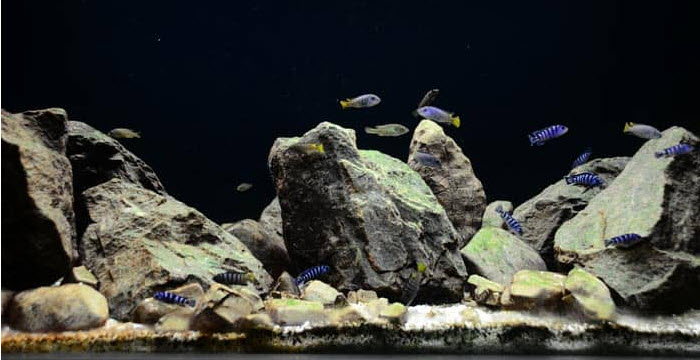
Summary of Stone Data
ALL rocks and stones you volition observe in your rock yard, yard or the local stream are fine just as is (i.e. no boiling or bleach), including those that bubble with acids like vinegar. Shells and corals are likewise perfectly safe with no treatment as are ALL gemstones, semi-precious stones, tumbled rocks, geodes, crystals, bones and antlers.
There are a huge number of very firmly held myths about rocks which just are non true. For instance, there are virtually NO rocks gems, geodes, polished stones, or crystals which are dissentious to fish in any way. At that place are a few rare minerals found deep inside mines that are poisonous only that is inappreciably a business organisation.
Whatsoever class of calcium carbonate ("bubbling in vinegar", limestone, coral rock, shells) can slowly raise the pH of the aquarium to 7.6 to 7.nine pH, no higher. This is a great pH for all adult fish. The only concern might be that in that location are a few species of blackwater fish which will not spawn in this water.
And information technology violates several laws of physics for a BOILED stone to "explode" (all the YouTube videos are of rocks in a Fire PIT which explode, a quite common occurrence). That existence said, since any fish you add together volition take a million times more fish pathogens on its torso that any stone tin can have, and you tin can't sterilize a fish, it is kind of dizzy to boil or oestrus a stone.
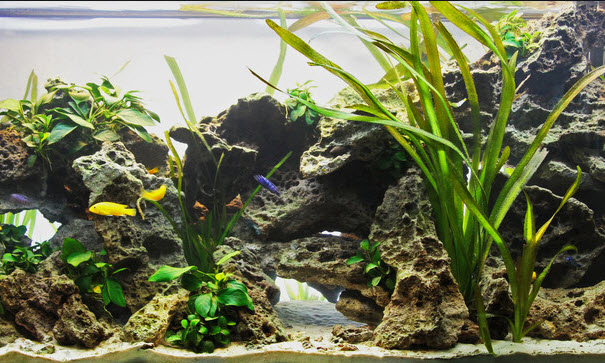
Note that the author is a degreed professional chemist and research scientist with a mineral collection with well over 1,000 specimens. And then this is a topic with which the author is a very qualified skillful.
But a Footling Common Sense
What is astonishing here is that if you testify a pile of various rocks on social media Everyone and I mean EVERYONE volition give you a long list of minerals to avert. And each list volition exist different. And every single list will be 100% incorrect! 100% Incorrect! Not one person, save the author, will tell you all the rocks are fine. I notice this degree of ignorance just incredible!
Note that saying this on social media volition invariably get some response from a "know-information technology-all nitpicker" like "What about azurite and malachite, they're poisonous?" Azurite and malachite are minerals found deep inside copper mines and are prized by mineral collectors. The chances of finding azurite or malachite lying nigh are about the same equally the chances of beingness hit and killed past a meteorite. And in any instance azurite and malchite will only dissolve in very acrid aquarium h2o. Other very rare poisonous minerals plant just in a few mines are ulexite, borax, realgar and orpiment. Note that other minerals like sulfur, fluorite, vanadinite and cinnabar non but are very rare and aren't found on the surface, they likewise aren't poisonous.
And as for poisonous explosive residue on rocks, if the rocks were quarried with explosive they volition have parts per billion of water soluble, easily degraded, nontoxic explosives on them till the beginning rain storm. And people will worry about this. LOL!
The same goes for coral or marine "live rock" which might possibly have had a very rare and exotic blazon of poisonous coral on it (some Zoanthid coral species contain palytoxin poisonous substance). As far every bit we can determine, in that location has never been a unmarried case of palytoxin poisoning of fish in the aquarium hobby. It is just theoretically possible. You have a far meliorate chance of winning millions in the lottery than killing your aquarium fish with toxic coral residual. Merely so the doomsday folks volition say "meliorate safe than lamentable". If yous want a hobby with absolutely zippo risk stick to knitting.
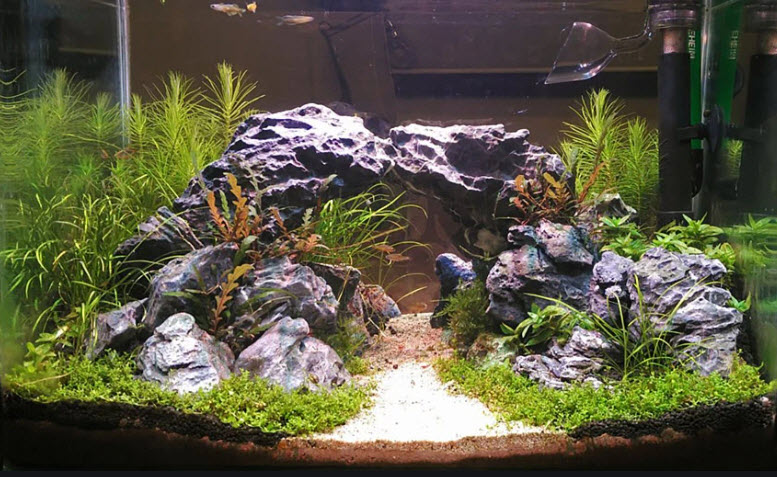
Isn't information technology interesting that streams tumble over all sorts of rocks, including i's that fizz, geodes and crystals, yet the fish aren't somehow poisoned or affected in whatever manner? And our well water, which has percolated through all sorts of rocks, isn't poisonous. Of all the billions of wells, ponds, lakes, streams and waterways in the earth at that place are just a few streams that drain human being-made things like industrial waste or mine waste which are in any way poisonous to fish. Yet anybody and their uncle will continue telling us to be careful about all that poisonous rock out in that location in nature.
And then there are the folks that come on social media with comments like "I added two rocks to my aquarium and the next 24-hour interval all the fish were dead". In that location is an erstwhile proverb in science, "correlation is non causation". The person, every bit is typical, added 2 new rocks when they did a water change. The water had been "super-chlorinated" past the water supplier (a very common occurrence!), overwhelming the conditioner used. And the chlorine killed the fish. And a myth is born.
Annotation that "store bought rocks" can have a small problem. Sometimes manufacturers glaze the rock with mineral oil to make them more attractive. Mineral oil won't impale fish only it tin interfere with aeration in the aquarium.
And so if you buy a colorful rock in your fish shop, test the stone by putting a drib of water on the rock. The water should moisture the rock. If the drop makes a round bead, you lot have oiled stone and it will need to be cleaned with some detergent in water. Just make certain to rinse it well equally the detergent is worse than the oil when it comes to toxicity to the fish.
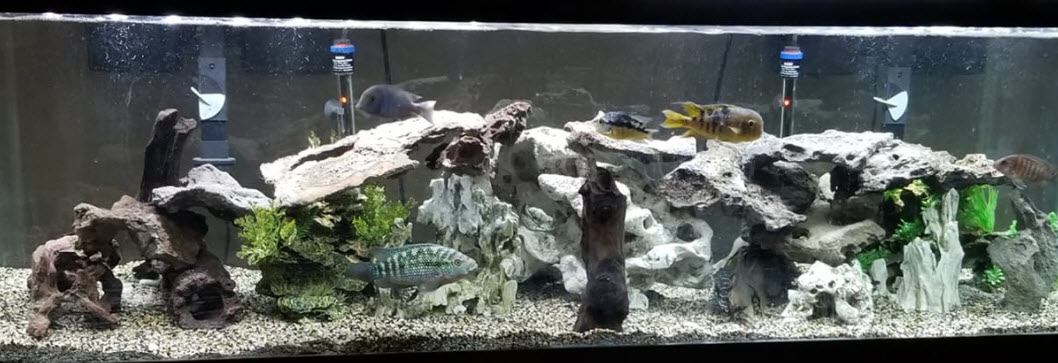
Myths in Depth
Rocks probably take more than parroted "myths" repeated most them than any other aquarium subject. Note that this article started out with well-nigh five "myths". Simply then the "myths" about rocks just kept coming. Nosotros're at present up to 24 myths. Every bit a professional person scientist, degreed chemist and gorging mineralogist, permit me put all of them to balance with a very lengthy, boring, verbous article which will only involvement the hobbyists who are complete nerds, like myself. We heartily recommend but skipping down to the particular myth one is interested in.
- Myth #i The "Vinegar Test" Indicates "Bad" Rocks
- Myth #two In that location are a Lot of Poisonous Mutual Minerals
- Myth #3 Lots of Gemstones and Semi-precious Stones are Poisonous
- Myth #iv Crystals and Geodes are Poisonous
- Myth #5 "Sparkles" and Iron are Poisonous
- Myth #6 Heavy Metals will Leach Out and Kill Fish
- Myth #7 Metals are Poisonous in an Aquarium
- Myth #viii Sharp Rocks can Cut the Fish
- Myth #9 Insecticides and Herbicides are a Problem on Rocks
- Myth #ten Information technology is Necessary to Boil or Bleach Rocks
- Myth #eleven Boiling Rocks tin can Explode
- Myth #12 Sandstone will Fall Autonomously in the Aquarium
- Myth #13 Porous Rocks Must be Cleaned with Detergents
- Myth #14 Green Rocks are Dangerous
- Myth #15 Shales Need to Be Avoided
- Myth #16 Shells Need to exist Coated
- Myth # 17 Os and Antlers will Decompose if not Coated
- Myth #xviii Be Careful of Radioactive Rocks
- Myth #xix Rocks from the Seashore Incorporate also Much Salt
- Myth #20 Avert High Silica Rocks like Quartz to Prevent Chocolate-brown Algae
- Myth #21 Pathogenic Protists will be Plant on Sedimentary Rocks
- Myth #22 Lava Rock is Bad As Information technology can Contain Sulfides and Carbonates
- Myth #23 Fresh Lava is Poisonous
- Myth #24 Lava Rock Decomposes Nitrate
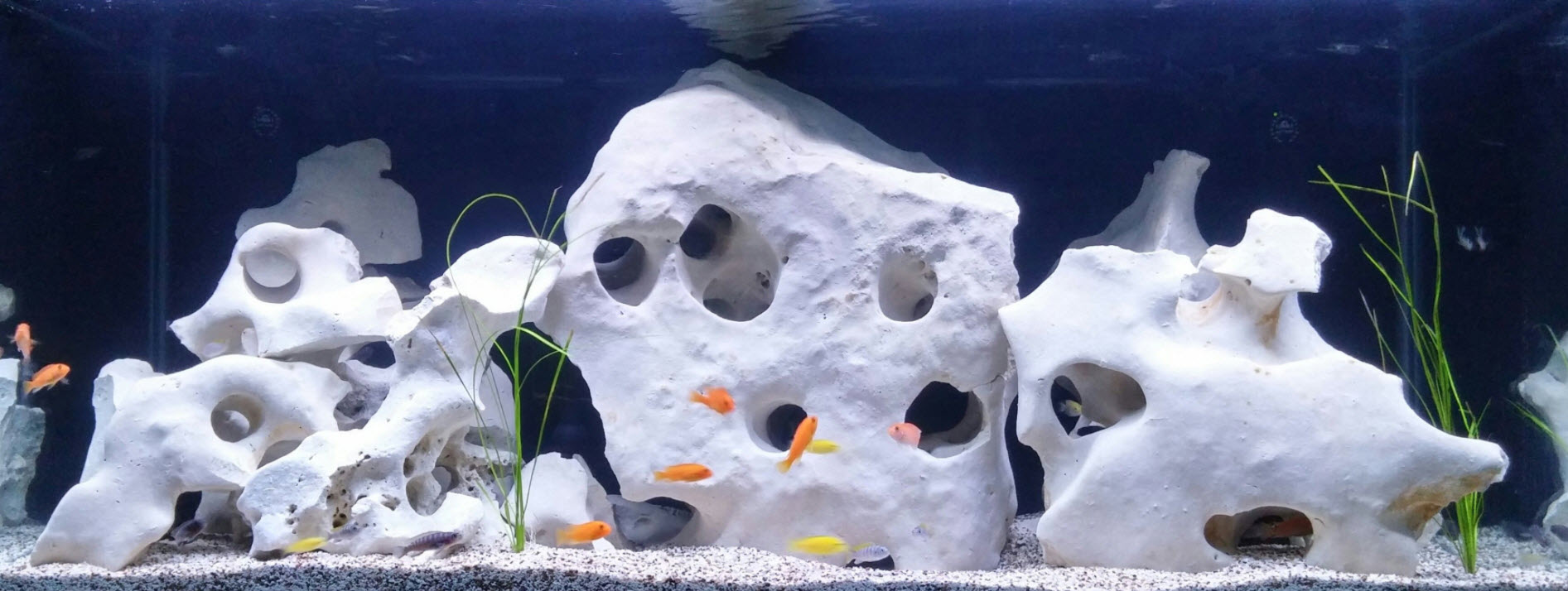
Myth #i The "Vinegar Test" Indicates "Bad" Rocks
Virtually aquarium owners know the "fact" that if you drop vinegar on a rock and it bubbles, the rock can't be used in the aquarium. This "fact" is simply wrong. Very incorrect.
First off the "vinegar test" doesn't work, period. If drops of vinegar are put on a stone which is calcium carbonate, the vinegar is too weak of an acrid to "fizz" and bubble. Modest bubbles will form with vinegar only very slowly when the rock is immersed in vinegar. Yous need to hit the rock with drops of a more concentrated acid such as hydrochloric acid (pool acid).
If a rock bubbling when hit with mineral acid it is the chemical compound calcium carbonate. Seashells, coral, Seiryu Rock, cuttlebone ("cuttlestone"), aragonite, limestone, travertine, calcite, marble, tufa, coquina, chalk and holey rock are all calcium carbonate. Whatsoever form of calcium carbonate dissolves a very modest amount in water with a pH below vii.6 to vii.nine. to create h2o which is only 7.6 to 7.9 pH, no higher.
Whole mountain ranges on earth are composed of calcium carbonate in the form of limestone. The mount ranges dissolve extremely slowly in carbon dioxide filled water, forming caverns over millions of years. If calcium carbonate dissolved more than the tiny amount that gives a pH of 7.6 to 7.nine, these mountain ranges would have dissolved away millions of years ago.
So whatever water with a pH of below seven.vi to 7.9 will be buffered to seven.half-dozen to 7.9 pH and only up to 7.6 to 7.ix pH by any form of calcium carbonate (the pH is never dropped by calcium carbonate).
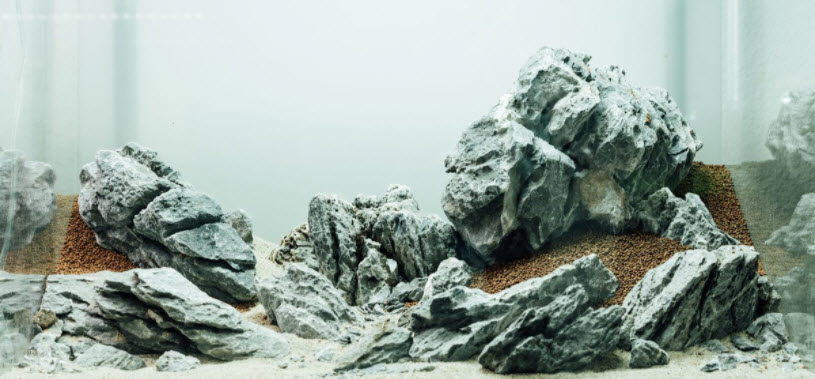
What non-chemists take difficulty wrapping their heads around is how pH is affected when in that location is something called an "equilibrium" prepare upwards. The calcium carbonate heads towards an equilibrium with the salts in the water. This equilibrium in water goes to an extremely low calcium carbonate concentration which will produce a buffered vii.six to 7.ix pH, no higher.
If the water is very pure and gratuitous of salts the equilibrium will go along faster to a college number. If the water has some salt content the equilibrium volition keep slower to a lower number.
Tests that were run on limestone rocks, coral and shells which confirmed this equilibrium. These tests can exist found at the following link:
14.ii.three. Buffering Substrates
Since a pH of 7.6 to 7.ix is a very good pH for whatever tropical freshwater fish these materials are skilful for fish, dandy for fish. At present many will take issue with the comment that "7.half dozen to vii.9 is a very good pH for whatever tropical freshwater fish" but it is simply true. The reasoning behind that mythbuster is explained at length in this link:
4.4.ane. pH is not Important
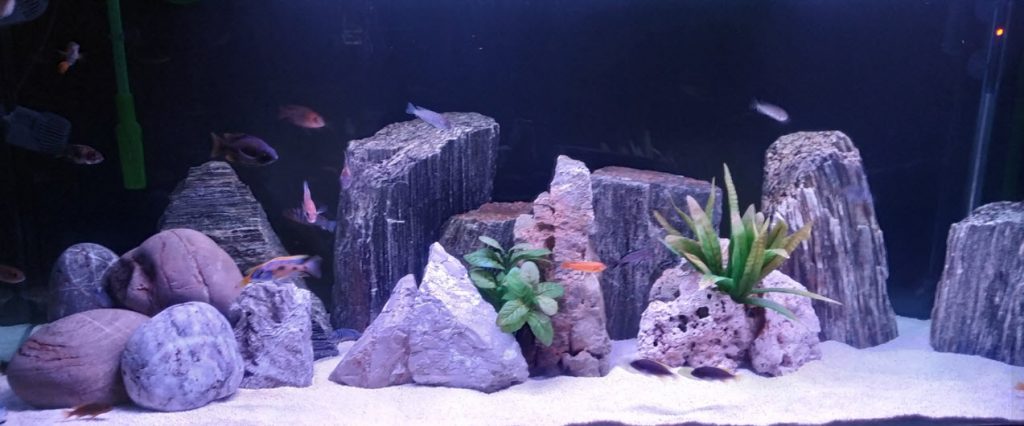
When the calcium carbonate dissolve a piddling bit and buffers the h2o information technology raises the GH ("Hardness"). GH ("general hardness" or "total hardness") is merely the amount of calcium and magnesium in the water. This is the white crap that builds upwards at the waterline of aquariums. GH is unimportant for ALL adult fish and well-nigh fry. But go along the pH between half-dozen.v and eight.5 and the total dissolved solids above 50 (i.e. all water except distilled and RO) and all developed fish do fine. GH and pH just become important in convenance a few species of fish. This mythbuster is discussed at length in this link:
iv.5.1. Full general Hardness
Now if you are trying to create an acid blackwater biotope for realism you obviously don't desire to add rocks which are calcium carbonate. Only the calcium carbonate won't hurt the fish that come from blackwater environments. Calcium carbonate will not change the appearance of a blackwater tank and won't affect the brown cloth i uses for coloration, whether that be tannic acid or peat acids.
Note that the dissolution charge per unit of the calcium carbonate rock is closely related to the area and the water menstruum over that area. A bag of crushed coal inside a filter will raise the pH to 7.5 in a affair of days. A chunk of holey rock in relatively withal h2o in the aquarium might take months to enhance the pH to 7.5.
Note that there are no rocks or minerals which volition significantly acidify alkali metal water. And if you add a calcium carbonate rock to a high pH water, similar more than viii.4 pH, the rock will have no effect on the pH at all.
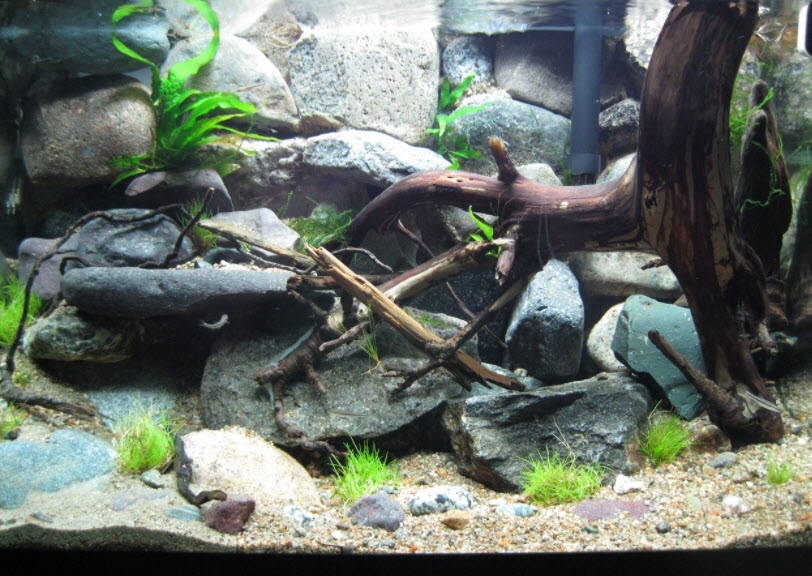
Myth #two There are a Lot of Poisonous Common Minerals
Aquarium Wiki website says to avoid; limestone, coral, amethyst, geodes, gypsum, ironstone, nephrite, marble, jasper types, sandstone and feldspar equally they are poisonous. This is just incredibly incorrect! For instance easily 75% of the rocks on earth accept feldspar in one grade or another in them. So if feldspar were poisonous all water on earth would be deadly. Sandstone is SAND, the same sand as one uses every bit a substrate in an aquarium! All of these minerals and rocks are perfectly safe and fine to utilize in the aquarium.
Here are ii other lists commonly put up on Facebook aquarium forums:

The But "unsafe" minerals in these two lists are ulexite, malachite and azurite. And these minerals are prized by mineral collectors and will certainly not be found in your local stream. These three minerals are also far too soft to be found in tumbled stones from your local jewel shop.
Y'all can grind up all the other minerals on these two lists into a fine powder and swallow them. That is how incredibly safety these minerals are. Shoot, "halite" is on this list. "Halite" is just some other word for table table salt. Sandstone is just SAND. Yeah – SAND. The same stuff anybody uses as a substrate. And aluminum is found in near EVERY SINGLE "Stone" in the entire earth. This degree of ignorance is just astounding to me. Lamentable. Can't sugar coat it.
An enterprising Facebook commentator looked upwards minerals which are dangerous if inhaled as a fine dust past gem workers or miners. If extremely fine grit of about any mineral is inhaled into the lungs of a homo there can be health issues such every bit silicosis. Since fish don't have lungs and rocks aren't extremely fine powders this is inappreciably a trouble.
Still some other site listed galena, hematite, pyrite, fluorite, selenite, celestite, iolite, turquoise, labradorite, lepidolite, mica, muscovite, talc, serpentine, moldavite, obsidian, opals, kyanite, diopside, epidote, hessonite garnet, grossulary garnet, zoisite, staurolite, amazonite and lapis lazuli as minerals which will leach and damage fish.
Every bit a degreed professional pharmacist with a huge mineral collection let me clinch you lot absolutely NONE of these rocks is damaging to fish in an aquarium. NONE! All these minerals can be ground into a fine powder and eaten by a human with no effect. Galena might leach a tiny amount of lead which will reduce i's IQ a few points but that isn't a problem with fish.
To give y'all some idea of how ludicrous this website is, this website says that fluorite will leach fluorine gas and impale the fish. Fluorite is calcium fluoride. The fluorine gas is extremely tightly bonded to the calcium and tin can no more leach out of fluorite than chlorine gas tin can leach out of table salt (sodium chloride). And fluorite is very insoluble.
Over again, this just goes to show how much incredibly false information is out there in the web. Anyone tin post anything and someone will believe them. Open websites similar Wikipedia and Aquarium Wiki are especially bad. There are websites claiming unicorns be and that nosotros never went to the moon.

A related myth is that soft minerals volition somehow dissolve in a tank.
"Just be certain not to utilise calcite, opal, or any "soft" stones on the MOHs scale nether a scaling of 7-viii. (Quartz is ane of the higher rated stones.) the softer the rock is, the more probable it is to dissolve and chip or leak minerals into the water."
And then a soft rock like opal which has been sitting around for a few million years in groundwater and rain is somehow going to dissolve in the aquarium? Huh? Soft mineral like opals generally exercise Not dissolve in water (opals are stored in h2o by gemologists!). And, oh, by the way, even if these "soft" stones could somehow dissolve in the aquarium the resulting water would be non-toxic to fish.
The mineral selenite is often listed as soluble and poisonous. Selenite has nothing to do with the poisonous element selenium. Selenite is pure calcium sulfate. Calcium sulfate is too known every bit "gypsum" or "Plaster of Paris". The feeding blocks one put in a tank to feed the fish while you lot keep vacation are fabricated of calcium sulfate. So, yep, selenite does slowly dissolve in h2o. Merely the event is completely harmless for fish. And calcium sulfate does non touch on the pH of the water.
When breeding fish and raising juvenile fish, many breeders add calcium sulfate to the water to requite the fish a adept source of calcium for good bones. Then selenite (calcium sulfate) is really beneficial in the aquarium.

Myth #iii Lots of Gemstones and Semi-precious Stones are Poisonous
Gemstones and semi-precious stones are all very inert and non-poisonous. If they were poisonous why would i wearable them around your neck as jewelry? Most of the "semi-precious" tumbled stones are quartz, which is very inert. Even the blueish copper rock, chrysocolla, is largely quartz, completely impermeable and insoluble and tin't possibly poisonous substance the aquarium.
One enterprising Facebook group ambassador went to Wikipedia and looked up the limerick of diverse gemstones (this includes "semi-precious" stones). If the gemstone said "colored by trace amounts of nickel" or something like, she said that this gemstone would thus poison the water of an aquarium. What she failed to realize is that nickel (or other "toxin") can't leach out of quartz, agate or any other gemstone. These minerals are NOT permeable. They can no more leach their coloring than coloring in a ceramic mug tin can leach out.
Hither is a nautical chart taken off of social media:
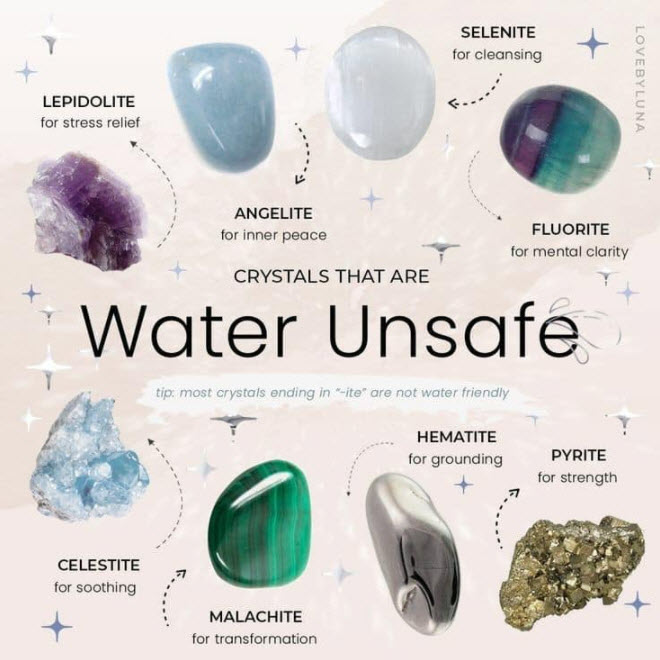
Let's look at these minerals. Hematite, fluorite and lepidolite are totally insoluble and are non-toxic even if they did dissolve so they are completely harmless. Pyrite will slowly be acted on by sure bacteria and converted to ferrous sulfate. Ferrous sulfate is used in planted aquariums as a fertilizer and is perfectly safe. Angelite and celestite are both strontium sulfate, which dissolves VERY slightly in water. Only strontium sulfate is harmless and doesn't touch the pH. Malachite will merely slowly dissolve in acid aquariums. And selenite is simply calcium sulfate, i.e. Plaster of Paris or gypsum, the same stuff that feeder blocks are made of. So, while selenite does slowly dissolve, selenite is perfectly condom. So this whole chart is a figment of someones imagination.
Still another site recommended to avoid turquoise as it is soluble in water and volition kill your fish. This is pure hogwash. Turquoise is an extremely insoluble hydroxy phosphate mineral. It is only soluble in concentrated hydrochloric or sulfuric acids.
I web site listed almost 100 "toxic crystals and stones". It makes for hilarious reading. Did you know emeralds, topaz and turquoise are all poisonous? LOL. Not sure if this list is funny or only sad. All 100 crystals and stones listed are perfectly safe, even if footing up and ingested. This just goes to show how much incredibly false data is out there in the web.
Then in that location was a person on Facebook who asked which of a agglomeration of tumbled semi-precious stones were OK to use in the aquarium. Ane of the commentators took the photo and drew a purple "X" through each tumbled rock that would "poison" the aquarium. This is the issue:
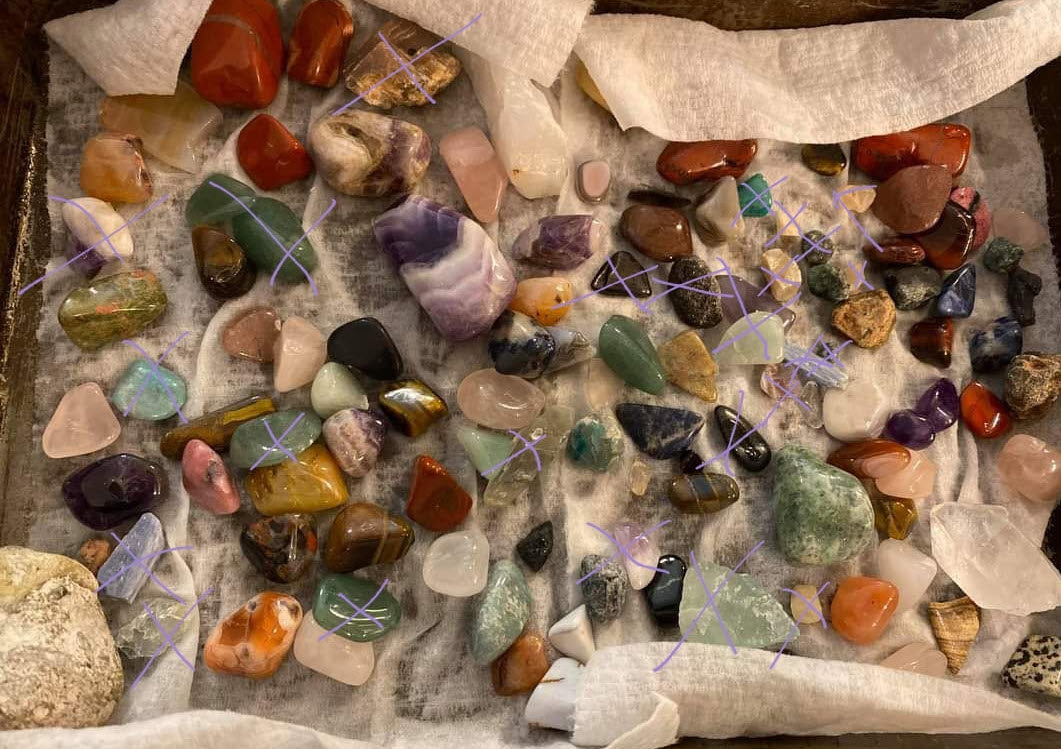
This is hilarious. There are majestic "10"s through about fifteen perfectly safe stones. I don't know whether this is a troll or just some incredible stupidity. Sorry. Over again I just tin can't saccharide coat it.
Tumbled stone such as the stones in the flick to a higher place are tumbled in barrel that is loaded with rocks, water, and abrasive grit. The barrel containing rocks, grit, and water is placed on a motorized machine that rotates the butt to tumble the rocks that are inside for days or weeks at a time. As the rocks tumble, they grind against ane another with particles of the abrasive grit caught between them. This activity wears sharp edges off of the rocks, smooths their surfaces and polishes them.
If a rock is soft and soluble in water information technology won't terminal inside a tumbler. Then ALL tumbled rocks are difficult minerals and stones which cannot mayhap poison whatsoever aquarium. The tumbled rocks are virtually all either forms of quartz (silicone dioxide) or complex alumino-silicates (feldspars, pyroxenes and amphiboles). In whatsoever instance even if these highly insoluble materials were somehow able to dissolve in h2o, the resulting solution would exist completely and totally harmless.
Old semi-precious forms of agate (a cryptocrystalline form of quartz) are dyed purple, dark-green or bluish. The dyes used are completely harmless to fish (typically aniline or phthalocyanine dyes). But there volition be many on social media telling you lot these stones are deadly poison. There are NO commercially used dyes which are poisonous. NONE! If they were poisonous they wouldn't be used as there are many perfectly rubber cheap dyes available for any color shade.
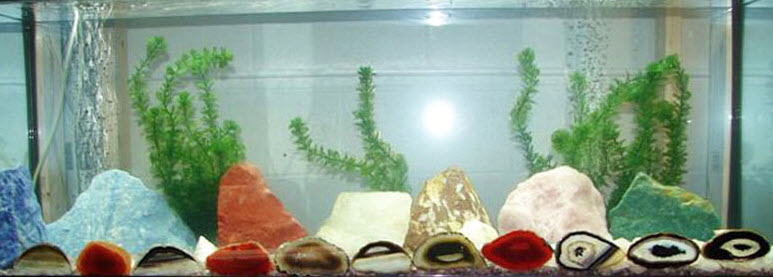
Myth #iv Crystals and Geodes are Poisonous
Most naturally occurring crystals are made from quartz. Almost all geodes are quartz. Quartz makes up about one quaternary of the rocks on the surface of the earth. It is what sand is made of. Challenge crystals or geodes leach poisonous metals is merely ludicrous. Yet mail a picture of crystals or a geode you want to put in your aquarium on Facebook and it is admittedly guaranteed that at to the lowest degree three people volition tell you lot information technology can leach poisons into the water.
At that place is a website (thesprucepets) which goes so far equally to say to avert geodes but that quartz is safety. Geodes are made of quartz! Duh!
Still other sites say that amethyst, agate and rose quartz are bad while quartz is fine. Amethyst, agate and rose quartz are types of quartz with very modest amounts of harmless impurities very firmly held inside the impermeable quartz matrix. Not just are the impurities harmless, they can no more leach out of the quartz than the coloring tin be leached out of stained glass windows.
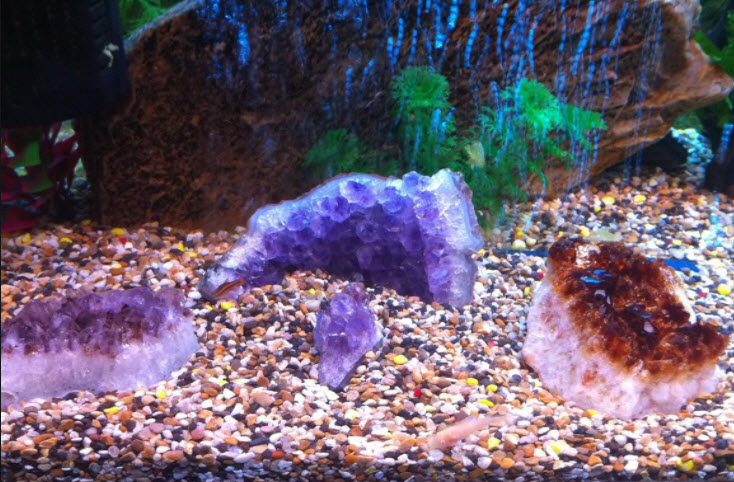
Myth #5 "Sparkles" and Iron are Poisonous
The most common form of "sparkles" in a rock is the mineral mica, an insoluble silicate which is very rubber in the aquarium, contrary to the many social media "experts" challenge it is poisonous. The various mineral species of mica are very common silicates and occur in nigh rock formations in one grade or another. If mica were poisonous, no water on world would be safe to drinkable.
Others claim the small particles of mica that bit off are "precipitous" and will cut the fish. Cut requires both a sharp edge and some hardness to that edge. Mica platelets are soft. They are actually quite slippery and class the basis of some high heat lubricants. They categorically cannot cut any fish.
Pyrite (a relatively rare form of "sparkles") is fe sulfide and completely non-toxic. Pyrite will very very slowly decompose into soluble iron sulfate. Iron sulfate is perfectly rubber with fish (the aquarium fertilizer Seachem Flourish Tabs is nigh 10% fe sulfate) and is removed past water changes. Iron sulfate is added equally an iron fertilizer by many hobbyists with planted tanks with fish in them with no effect what-so-always on the fish. Atomic number 26 sulfate is slightly acrid but so petty of it is added at any time from pyrite that it cannot affect pH i iota. Even if huge amounts of iron sulfate were added to the water, it would but reduce the pH possibly one-half a signal.
Some say to avert whatever rock with orangish or reddish stains on it. These stains are rust. Rust is iron oxide (actually a complex of ferric oxides and hydroxides) and insoluble in water and perfectly safe. If rocks with iron oxide stains in them were in any way poisonous no water on earth would be condom as iron oxide is a very mutual mineral (5% of the world chaff is the element iron).
And metallic fe ("steel") is perfectly safe for fish. If yous consider that the rotor of every pump motor in your tank is a cylinder of pure ferrite (magnetic atomic number 26 powder sintered with strontium, barium, etc.) rotating at high speed on a steel spindle in constant contact with the water and at a temperature to a higher place the tank ambient (i.e. perfect conditions for chemical reactions) you tin run into that there is lilliputian need to worry about a few rust stains on rocks.
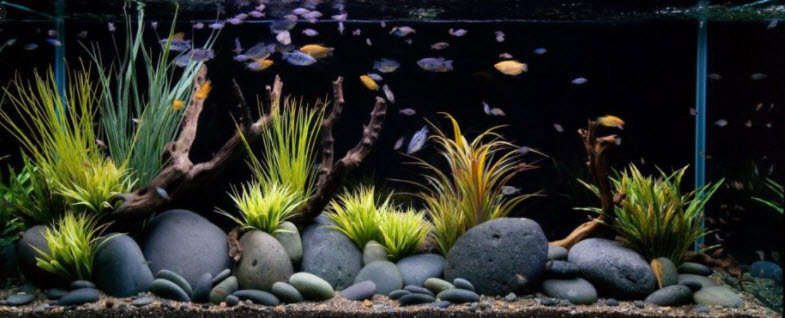
Myth #6 Heavy Metals volition Leach Out and Kill Fish
No rocks will take "heavy metals which tin can leach out" unless you happen to be in Bullpen Oklahoma (big zinc/lead mine). And even a rock filled with lead from Bullpen Oklahoma will just very slowly dissolve in an aquarium, maybe reducing the IQ of your fish past a few points. The levels of lead or whatsoever other heavy metal needed to kill fish are quite loftier.
There most certainly are no rocks or gemstones which contain heavy metals or whatsoever metals in any course which tin dissolve in water. If they dissolved in water why are they still in a rock which has been soaked by groundwater and rain for several one thousand thousand years?
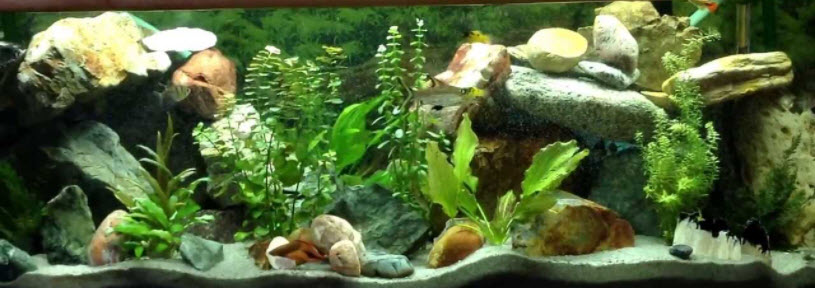
Myth #7 Metals are Poisonous in an Aquarium
I love the commentator who said to be very conscientious because many rocks accept "veins of metal in them" and need to be avoided. If y'all find a bunch of rocks with veins of metal in them please bulletin me. I'll purchase the land the rock is on, mine information technology and make a fortune. "Veins of metallic" are extremely rare occurrences in nature, very valuable when they are found and aren't poisonous when they do occur.
A related myth is that metal parts demand to exist avoided in the aquarium every bit they will decompose and kill the fish. The comment typically runs: "That decoration has metallic screws which must be replaced as they will corrode and toxicant your fish".
Metal screws are typically steel. Steel is elemental iron with a little carbon in it. The iron volition slowly class "rust", a mix of ferric oxides and hydroxides. This rust is insoluble and completely harmless even if information technology were soluble. The aquarium fertilizer Seachem Flourish Tabs is about 10% iron sulfate and harmless to fish. Atomic number 26 is in no fashion poisonous. Then steel screws are harmless in an aquarium. The ferrous grade of iron is toxic to plants at levels higher up 50 ppm BUT in the h2o of an aquarium the ferrous form of fe is oxidized to insoluble and harmless ferric forms very quickly. So even this is not a concern.
Some screws might be contumely. The amount of copper and zinc which might leach out as screws corrode is tiny. Information technology is harmless to even sensitive creatures like shrimp. The just problem might be with saltwater corals in reef tanks. Now of course it is alway possible to have also much of anything. I would be hesitant to put something similar a sheet or chicken wire of zinc coated (galavanized) steel in an aquarium. This might produce an overload of zinc. The same goes for copper sheet.
And then some say to never put aluminum foil in an aquarium as the fish will exist poisoned. Interesting. Many years ago I made some aquarium backdrops from painted aluminum foil and my fish were just fine. Aluminum in water forms tiny amounts of aluminum hydroxide which might come free as tiny particles and bladder effectually the aquarium. Aluminum hydroxide is the agile ingredient in Mylanta antacid and is completely harmless to fish.

Myth #8 Sharp Rocks can Cut the Fish
There are a few types of fresh burnished lava that accept edges capable of cut a person's hands if the edges are pressed against the hands. These rare lava'due south are only found in areas with fresh eruptions so won't exist found in the aquarium.
The edges of ALL other rocks are far too dull to cut through the peel of a fish. This includes the edges of crystals and the edges of lava rock used in aquariums. If the rock is as well dull to cut your hand it will be too irksome to cutting a fish. And note that whatsoever "cutting" activity requires two matter: a sharp edge and a forcefulness applied to the border by an object similar a fish. Most fish are too pocket-size to create enough forcefulness to cutting themselves on even something similar a knife blade put in the water.

Myth #9 Insecticides and Herbicides are a Problem on Rocks
And how many people take sprayers full of insecticides and herbicides, go down to the local h2o way, and spray the rocks lying around? So worrying near pesticides or herbicides on virtually rocks is a little ridiculous. In any case insecticides impale insects, not fish. If one's fish have anchor worms 1 treats the anchor worms past calculation an insecticide to the aquarium.
While some herbicides can kill fish in high concentrations, virtually all herbicides simply have lifetimes measured in days. For example Roundup is non toxic to fish 1 day after application. So even rocks from your yard are fine if they haven't been sprayed with herbicides in a week or so.
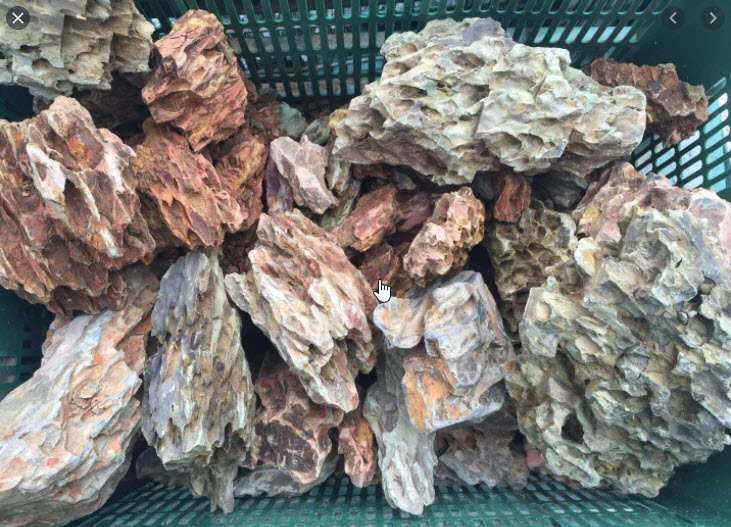
Myth #10 It is Necessary to Boil or Bleach Rocks
And why would one eddy a rock or hit information technology with bleach? A fish or a establish added to the fish aquarium from the LFS has a million times more than fish pathogens on it than any rock could possibly accept. And y'all can't sterilize fish or plants.
The often heard type of refrain is "I added rocks and my fish died of internal parasites over the side by side two months". In that location is an old saying in science "correlation is non causation".
All the "internal parasites" that are fish pathogens (hexamita, capillaria, camallanus, fish TB, aeromonas, columnaris, etc.) are found on the majority of apparently good for you fish in most aquariums by pathologists.
So a hobbyist added some rocks and probably cleaned their filters at the aforementioned time. They created an unhealthy surroundings by cleaning their filters and "internal parasites" that were in the fish bankrupt out and killed the fish. It had nothing to exercise with the rocks. The chances of internal parasites being on a rock from a stream are probably ane in a million. The chances of internal parasites being in a fish are about 500,000 in a million. Y'all practice the math.
At that place is a very slim hazard with any rock from a stream that it might peradventure take hydra or planaria on it. If i is concerned nearly hydra or planaria i could soak the rocks in hydrogen peroxide or potassium permanganate. Merely be enlightened the live plants you're getting probably have far more hydra and planaria on them than any rock could possibly take.
Note that many, including the writer, deliberately use wet rocks (and mud!) from lakes and streams to introduce organisms into the aquarium. The greater the biodiversity in a fish tank the healthier the aquarium will be. If ane strives for a sterile aquarium i will only achieve an aquarium with a lot of pathogens in it. This topic is covered in this article:
two.fourteen. The Mature Aquarium
And a mossy stone is harmless in the aquarium. The moss will just decompose and disappear with time. If concerned but scrub it off.
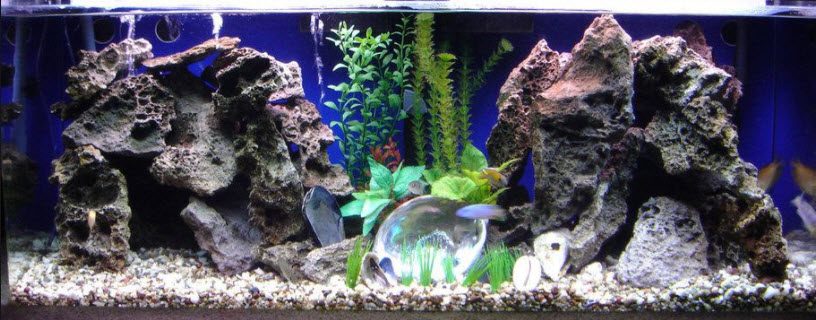
Myth #xi Boiling Rocks tin Explode
It is ridiculous to boil a stone but some people volition do it. They will and then be told on social media: "That boiled stone could accept exploded and killed you". LOL
At that place are a bunch of people on social media which accept noticed that rocks in a burn pit explode. Yep! rocks in a fire pit often explode. It is quite mutual. The science backside these explosions is very well understood (they are high temperature and high pressure level steam "explosions"). Merely there is a HUGE difference between a campfire and a pot of boiling water. A rock in a pot of water brought to a boil just cannot explode. The science backside this is quite firm. It just cannot happen without violating several bones laws of physics.
Think of it this fashion. The reason a rock would explode is because of h2o inside it apace expanding and turning into steam. Only keeping water under pressure level such as it is inside a stone raises the temperature required for the water to plow to steam (a bones police force of thermodynamics!). Exterior a stone, water takes 212 degrees before turning into steam. Within a stone information technology takes 500 to 1,000 degrees for h2o to turn to steam.
A bivouac can raise the temperature inside a rock to 500 to 1,000 degrees and a rock can "explode" due to the formation of a apace expanding steam pocket. Note that in actuality the rock normally just splits into two pieces with a loud blindside, the two pieces ending up inches from each other, inappreciably a hugely dangerous situation.

It is impossible for the water surrounding the rock in a boiling pot to exceed 212 degrees, the temperature of the humid water (via a basic constabulary of thermodynamics). So the temperature inside the rock cannot mayhap exceed 212 degrees. So steam inside the rock in a pot of boiling water is impossible. And an explosion in a pot of boiling water is impossible.
Note that a rock with air in information technology, such as pumice, does not explode when heated. The common refrain is that if yous boil a rock, in that location can exist air pockets inside the rock which "explode". Can't happen!
The air force per unit area created by even one thousand degrees is insufficient to blow upwardly rock, per some other law of physics, namely the ideal gas constabulary, or Boyles Police force, PV=nRT. The temperature of boiling h2o, namely 212 degrees, certainly can't cause an "air explosion". The air inside pumice will become from 14.6 psi at lxx degrees to roughly 17 psi at 212 degrees. 17 psi minus 14.6 psi = ii.4 psi. A force per unit area of only ii.4 psi will not cause anything to explode. When you blow out a candle you create more than 2.4 psi of air force per unit area.
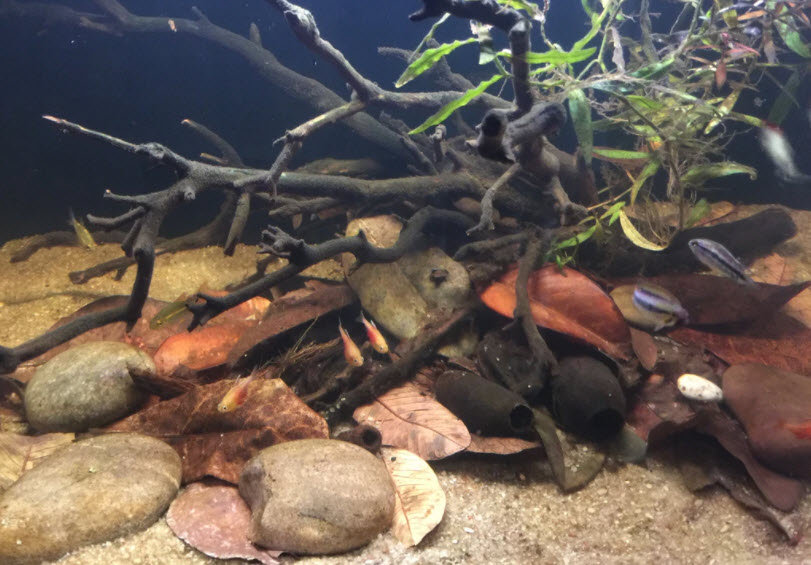
Now that existence said if 1 has a pot of boiling h2o and one drops a rock into the boiling water, the rock can theoretically loudly "crack" and intermission autonomously due to differential thermal expansion. The exterior of the rock chop-chop expanded while the inside of the stone did non aggrandize. But this "crevice", but a loud noise, will hardly exist sufficient to "break a window side by side to the stove" or "kill you". Note that thermodynamic energy considerations say this cannot happen in real life, the temperature departure betwixt room temperature and 212 degrees is also pocket-sized. But we'll mention it equally a very remote "possibility".
When anyone asks about humid rocks in social media at least xx individuals come up and say "never boil rocks because they explode". When asked for some proof that this actually happens they typically don't answer. A few respond with a YouTube video of someone with a bivouac and a bucket of water. The person takes out a very hot rock from the fire and places it into the water (probably a 600 to 800 caste temperature differential). And the stone breaks apart with a very small "explosion" of water.
This is due to differential thermal expansion (i.due east. "thermal shock") and has cipher at all to practise with putting a rock into a pot of water and boiling information technology. It "proves" nothing. There is a HUGE difference between heating a stone in a fire pit and heating a rock in a pot of water.
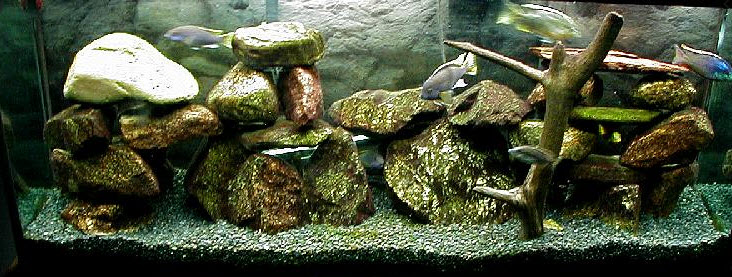
Myth #12 Sandstone volition Fall Autonomously in the Aquarium
Many folks take heard that one needs to exist careful with some rocks similar sandstone and shale because they will fall apart in the water of an aquarium and become sand. Interesting! Let me get this direct, a stone which has been exposed to ground water and rain for at to the lowest degree several k years is going to fall apart in a short time in the aquarium. Huh?
There is a material chosen "mudstone" which is basically just dried hardened clay. This will fall apart in the aquarium. But it won't be found in the open in nature due simply to the fact it will disintegrate in rain. I has to dig this "stone" out of the earth.
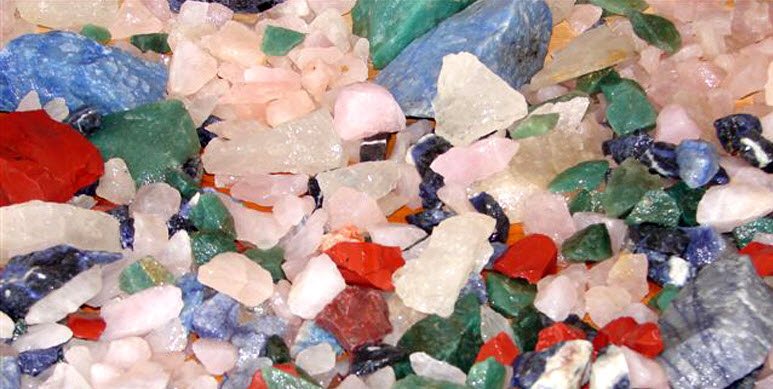
Myth #thirteen Porous Rocks Must exist Cleaned with Detergents
This is probably the well-nigh dangerous myth. One commentator said that porous rocks will absorb toxins from the environment and need to be thoroughly cleaned with dish washing detergent before beingness added to an aquarium. Three points:
- What toxins? Last fourth dimension I checked my local rattlesnake population was not going around spraying their venom on the local rocks. And the insecticide/herbicide "problem" doesn't be (encounter in a higher place).
- Detergents brand oil and water mix. Toxins from nature aren't oils. So why clean with detergents?
- Detergents destroy the lipids in the jail cell membranes of the gills of the fish. So detergents are poisonous to fish.
Then you're going to "clean" rocks which probably do not have a fish toxin on them with a known fish toxin. Huh?

Myth #14 Green Rocks are Dangerous
If you happen to exist in the vicinity of a copper mine and you option up a dark-green stone from the copper mine dumps, the rock volition have small amounts of copper silicates in it. These copper silicates are insoluble and harmless in the aquarium. Also, reverse to popular myth, it is very rare to find any copper minerals in nature.
If you find a light-green rock anywhere just in the vicinity of a copper mine, the rock can be colored by any i of many common green silicate minerals. These include: peridotite, actinolite, serpentine, olivine, chlorite, glauconite and pyroxene. These common green silicates are completely harmless.
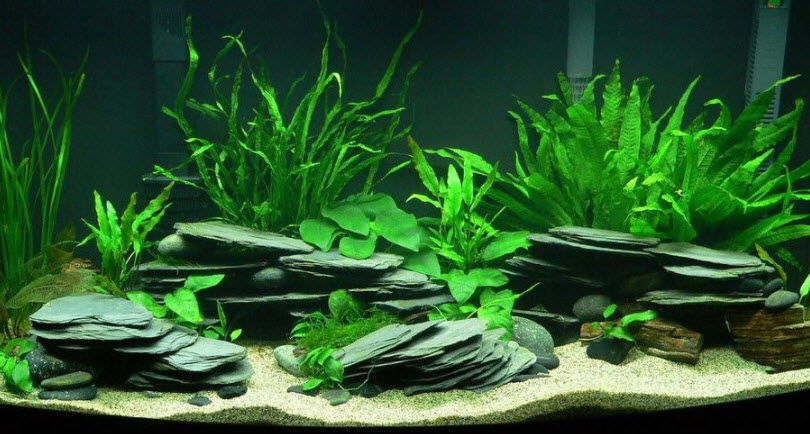
Myth #xv Shales Need to Be Avoided
This narrative gain along the line of "some shales are filled with oil and tin poison your fish with petroleum residues". Interesting. First off oil shales are very rarely found near the surface (in the Us this is express to Southwest Wyoming). Secondly oil shales about the surface will take evaporated all the oil residue from themselves thousands of years ago. And so even if you are in the oil shale regions of Wyoming the oil shale rocks you might perhaps find are totally harmless.
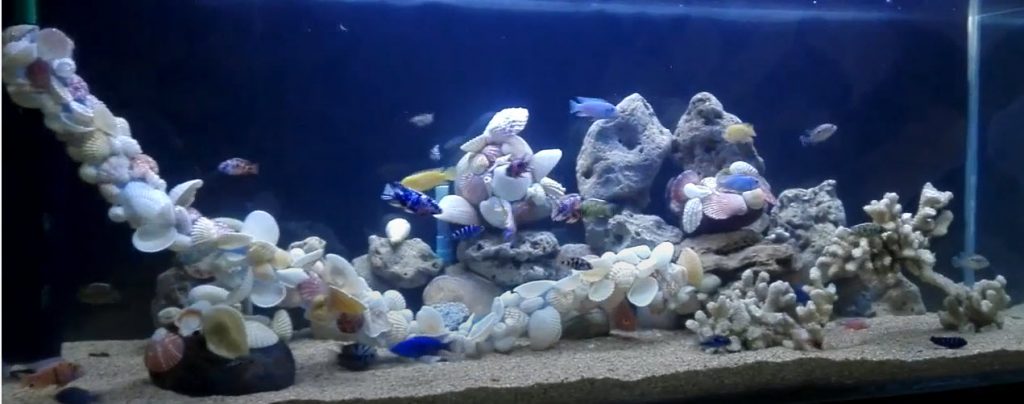
Myth #16 Shells Need to be Coated
Shells and coral are typically well-nigh 98% pure calcium carbonate, the same thing equally limestone. Indeed, most limestone is just shells and coral that has been buried in the earth and "metamorphosized" into rock. So the dissolution rate of shells and coral is extremely boring and merely very tiny amounts deliquesce to go to the 7.six to 7.9 pH equilibrium. So shells or coral practice non need to exist sealed in lacquer or epoxy in the aquarium. They volition terminal for many years in about aquariums.
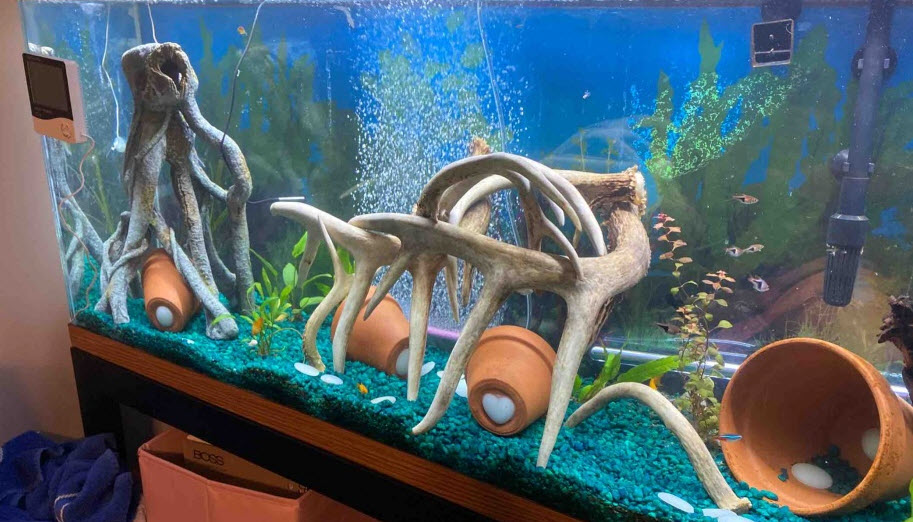
Myth # 17 Bone and Antlers will Decompose if not Coated
An animal skull is a type of bone, a composite material consisting of both inorganic and organic components. The inorganic component is primarily crystaline hydroxy apatite: [Ca3(PO4)2]3Ca(OH)2. This apatite is a VERY insoluble material. The organic component of bone comprises more than thirty proteins with type I collagen being the nearly abundant (>90%). By dry out weight, the inorganic apatite constituent accounts for nearly 67% of the tissue while the organic poly peptide component makes up approximately 33%.
The protein in fresh bone Tin decompose relatively rapidly in the aquarium and Tin can maybe create h2o quality bug, sealed or unsealed. Personally I've never seen a problem simply recollect, my tanks are all very over filtered and so decomposing proteins will exist rapidly converted to harmless nitrates. In theory a new filter or a filter with poor media could take a problem with new bone. Sometime aged bone is merely insoluble apatite and can concluding for many years in an aquarium without any blanket.
Antlers are likewise "bone" but have a slightly higher organic protein content (40% to 50% by dry weight). Antlers tin can thus decompose a little faster in an aquarium than can a skull. But aged antlers will still rarely create a probem in an aquarium and volition however last most as long every bit a skull.
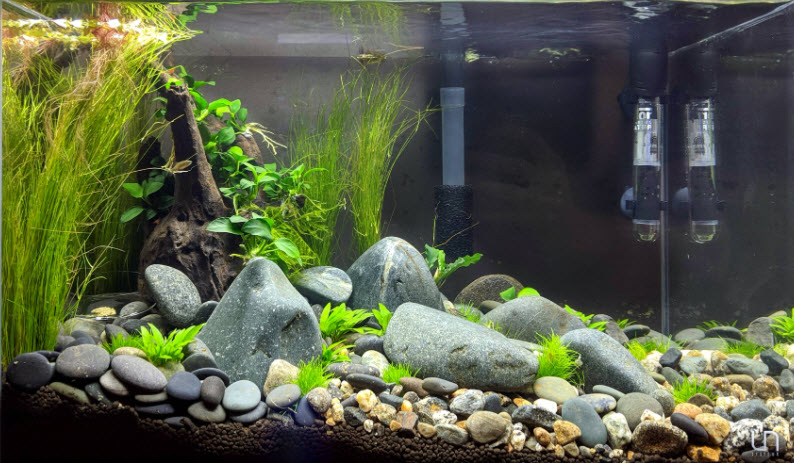
Myth #eighteen Be Careful of Radioactive Rocks
"There are radioactive rocks which can kill your fish". Yep, someone came upwards with this ludicrous claim on Facebook. Unbelievable! The only radioactive mineral one might possible very rarely come across is a very rare yellow crumbly mineral called "carnotite". It is an oxide of largely uranium.
The uranium image has suffered from its clan with the showtime atomic bombs. Its reputation as a malevolent radioisotope, however, is undeserved: in fact, the decay rate of uranium is among the slowest known to man. The half-life of uranium is of four.5 billion years, which means information technology has VERY low radioactive decay. The activity of a sample of uranium could be compared to the water flow escaping from a large lake through a pinprick.
Opposite to the widespread fears, uranium presents low risks owing to its very low radioactivity. Its radioactive toxicity, according to experts from the Nuclear Regulatory Commission, is a hundred times weaker than its chemic toxicity, which itself is no different from the chemic danger posed by common heavy elements such equally pb.
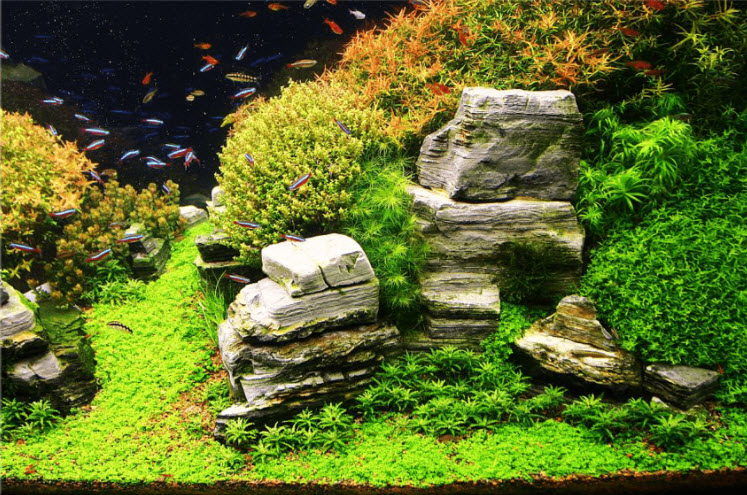
Myth #19 Rocks from the Seashore Incorporate as well Much Common salt
The corporeality of salt establish on seashore rocks or coral is infinitesimal and harmless. Salt is very soluble, so one won't have large crystals of table salt sitting inside a piece of coral or rock, obviously. And notation many ascribe to adding salt to a tropical fish tank as a tonic, a do which is harmless.
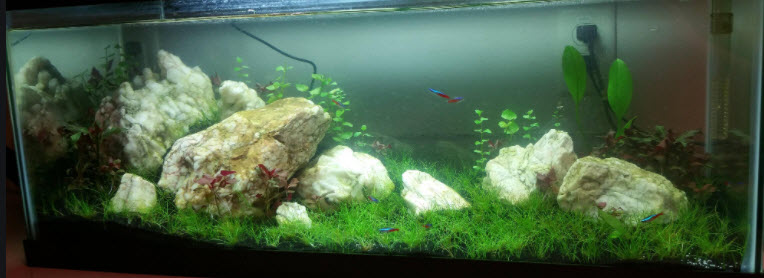
Myth #20 Avoid High Silica Rocks like Quartz to Preclude Brown Algae
A type of algae ("brown algae") called "diatoms" require silica to form their shells. Supposedly, according to this myth, rocks with silica in them cause chocolate-brown algae outbreaks in the aquarium. First off most all tap h2o has 5 to 15 parts silica in information technology. At roughly 10 ppm silica comes to equilibrium at room temperature. Silica forms ninety% of the composition of the surface of the world then getting water without some silica in it is nigh incommunicable. And it takes some fourth dimension for silica to dissolve out of even fine sand.
The surface expanse of rocks is very low compared to the surface area of other silica sources such as sand or gravel. There are NO aquarium substrates which do non accept silica in them. So if 1 has RO water, distilled h2o or rain water the substrate will raise the silica level thousands of times faster than any rock peradventure can. If ane has a glass aquarium, the amorphous forms of silica found in glass will dissolve much faster than the forms of silica plant in rocks. So rocks cannot raise the silica level.
And finally 'brown algae" is not e'er diatoms. It is often a whole host of other organisms which will form even in silica free water. Brown algae is a natural and unavoidable part of the ecology organization in whatsoever aquarium. I should only learn to live with it.
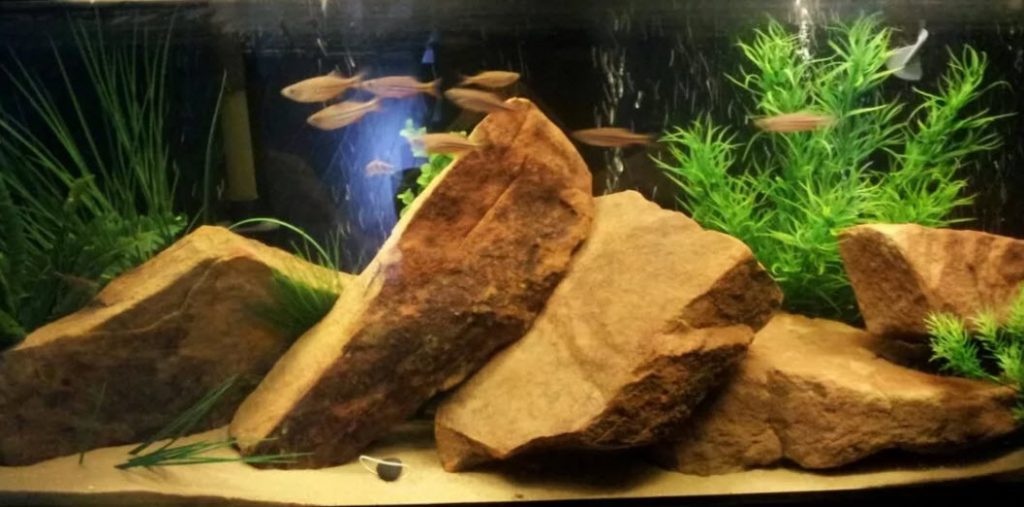
Myth #21 Pathogenic Protists will exist Plant on Sedimentary Rocks
1 YouTube "expert" has a video where he says to avoid all sedimentary rock as information technology is porous and will have all sorts of bad "protists" on it similar unmarried celled algae and protozoans. And according to this well meaning but wrong "skilful", porous stone must be avoided because it will harbor "little protists that y'all don't know". Yes, porous rock volition harbor all sorts of "protists that you do not know". But they are ALL beneficial to the ecology of the aquarium. And in whatever case unless the rock was found in water the protists one might find volition probably dice submerged in water.
It is very difficult for people to understand that near every fiddling single celled organisms you lot find in nature, all the trivial "protists", are beneficial in the aquarium. The more little types of "protists" one has in the aquarium the amend the ecology of the aquarium will be. Even the leaner ane finds on sedimentary rocks in nature will be benign in an aquarium. Fish pathogens come up in on the fish, not on the rocks. Annotation that the definition of the term "protist" is somewhat vague and constantly changing, simply generally means single celled algae, amoebas, and ciliates (such as paramecium).
Note that many, including the author, deliberately utilize wet rocks (and mud!) from lakes and streams to introduce organisms into the aquarium. The greater the biodiversity in a fish tank the healthier the aquarium will be. If one strives for a sterile aquarium one volition but achieve an aquarium with a lot of pathogens in information technology. This topic is covered in this commodity:
2.14. The Mature Aquarium
This "expert" likewise goes on and on how one should avoid green rocks like serpentine as they might incorporate copper. Unless the light-green rock is institute in a copper mine it will Non contain copper. At that place probably isn't a serpentine rock in the entire globe that contains copper. The light-green color in serpentine is due to greenish amphiboles, and not due to copper. And fifty-fifty if the stone did contain copper information technology volition not exist in any form which tin can leech out and impale something similar snails or shrimp.
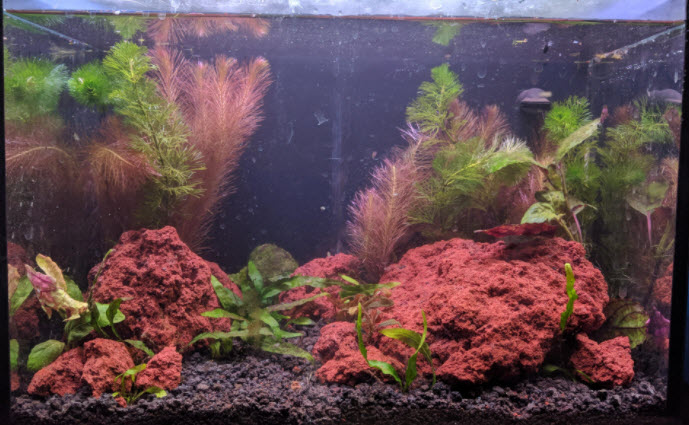
Myth #22 Lava Rock is Bad As It can Incorporate Sulfides and Carbonates
Some other commentator, a "degreed geologist" warned that lava rock can have "poisonous" sulfides like pyrite in the matrix. Yes, mayhap one in a grand lava flows take pregnant amounts of pyrite (iron sulfide) embedded in the silicate mineral matrix. But pyrite is Non POISONOUS (run across word above) and simply dissolves very slowly when acted on past certain bacteria. Other metal sulfides such as cinnabar do not occur in lava flows and are non poisonous if they were plant.
This same "degreed geologist" warned that lava rock tin leach carbonates which will change the pH of the water. There is one volcano in the world (in Tanzania) flowing carbonate lava. Because carbonate lava typically is largely sodium carbonate (baking soda) it rather quickly dissolves in near environments. And I very much doubt if the lava from Home Depot is from Tanzania. In any instance, carbonate is beneficial to the aquarium, dandy for information technology (see above discussion). Sooooo….what?
This is only typical nit-picking by someone intent on showing off their knowledge.
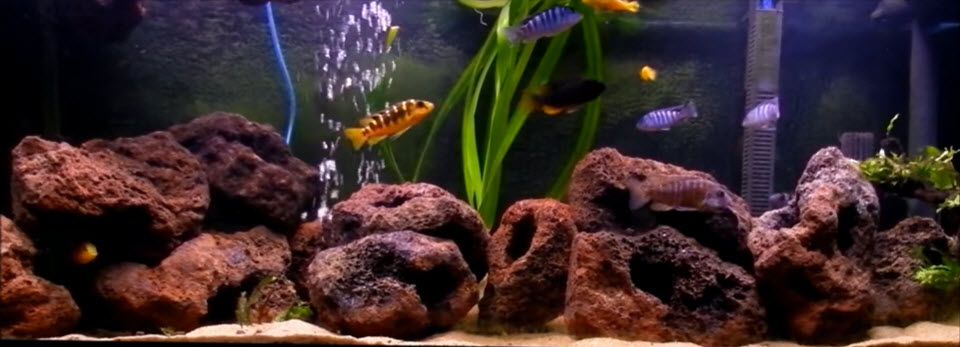
Myth #23 Fresh Lava is Poisonous
I thought I'd heard it all till this annotate came up on social media: "Lava rock is merely suitable for aquariums once it has been weathered and cleaned. When fresh it is quite poisonous". Huh? Lava is simply molten rock. It is a complex mixture of alumino silicates which can no more poison a fish than any other rock can poisonous substance a fish. Information technology just is incommunicable. I asked the person who made this annotate "what exactly were the poisons that the comment was referring to?". I did not go an answer. ALL lava rock, even "fresh", is merely fine in the aquarium.

Myth #24 Lava Rock Decomposes Nitrate
There are websites (aquaessentials.co.united kingdom of great britain and northern ireland and Aquariumfish.net) which claim the following most lava rock in an aquarium:
"You only accept to inspect the rock and you can run into it is covered in tiny holes making it extremely porous allowing water to laissez passer through and diffuse into the stone. So what does The Hidden Benefits of Lava Rock really mean? An anaerobic environment is created inside the stone as benign nitrifying bacteria consume all the oxygen in the water. Inside this anaerobic surround inside the stone, denitrifying leaner consume the nitrate and produce oxygen and nitrogen. Nosotros all know how nitrate in the aquarium is bad news for fish and shrimp so lava rock really is the most natural and best style of removing nitrate."
I tin't sugar glaze information technology. This argument is pure and simple hogwash. Here are some lengthy manufactures which go into the myriad of reasons this is hogwash.
xiv.2.4. Anaerobic Substrates
7.5. Denitrifying Filter Media
Note that the term "lava stone" in this quote is linked to website that sells lava rock. Click on the link, buy some lava rock and the website gets a commission. Don't yous just love the turn a profit motive?
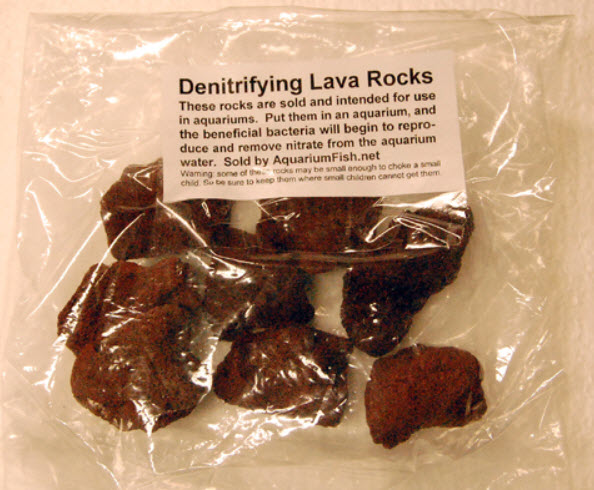
Again, let me emphasize, lava rock categorically does absolutely NO removal of nitrates to nitrogen gas. It is completely and totally incommunicable. If y'all believe that lava rock can remove nitrates delight contact me. I have a pill that will add twenty points to your IQ, make you very attractive to the reverse sex activity, and take twenty years off your age. It is only $998. Oh, and ignore the letters B-A-Y-E-R on the pills.

Rocks in an Aquarium
Belief Perseverance Issue
Note that the author is a degreed professional chemist and research scientist with a mineral collection with well over i,000 specimens. When this fact is posted together with the in a higher place analysis you would be amazed at how many people say that the writer is dead wrong and does not know what he is talking almost. 1 lady called the author an idiot. LOL
This is the psychological phenomenon of "conventionalities perseverance issue". Even when presented with the science from a legitimate scientist, people volition rationalize and rationalize to uphold a conventionalities they have held for a long time. We don't fifty-fifty endeavor to fight this phenomenon.
.
"Zilch dies harder than a lie that people want to believe" Calvin
.
For our aquariums we merely make clean the stone of any loose soil or debris then add it to the aquarium.
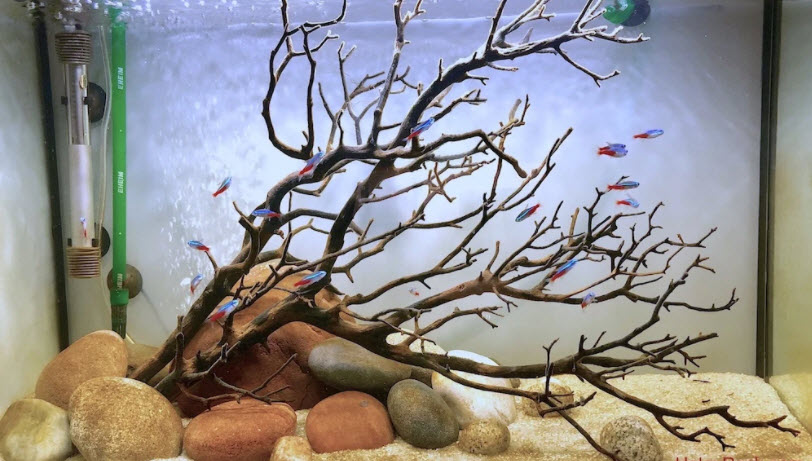
Wood
Many come up on social media and enquire things like "can I use forest and rocks constitute in my thou in my aquarium". Wood, just like rocks, has all sorts of myths parroted about it. The truth well-nigh wood can be constitute in the link:
xiv.10. Forest In the Aquarium
.
Return to Equipment Menu
.
Aquarium Science Website
The capacity shown below or on the right side in maroon lead to close to 400 articles on all aspects of keeping a freshwater aquarium. These articles take NO links to profit making sites and are thus unbiased in their recommendations, different all the for-profit sites you will find with Google. Bookmark and browse!
.
Source: https://aquariumscience.org/index.php/14-3-rocks/
Posted by: grindlenonvize.blogspot.com


0 Response to "How Often Does The Aquarium Lava Rock Need To Be Cleaned?"
Post a Comment